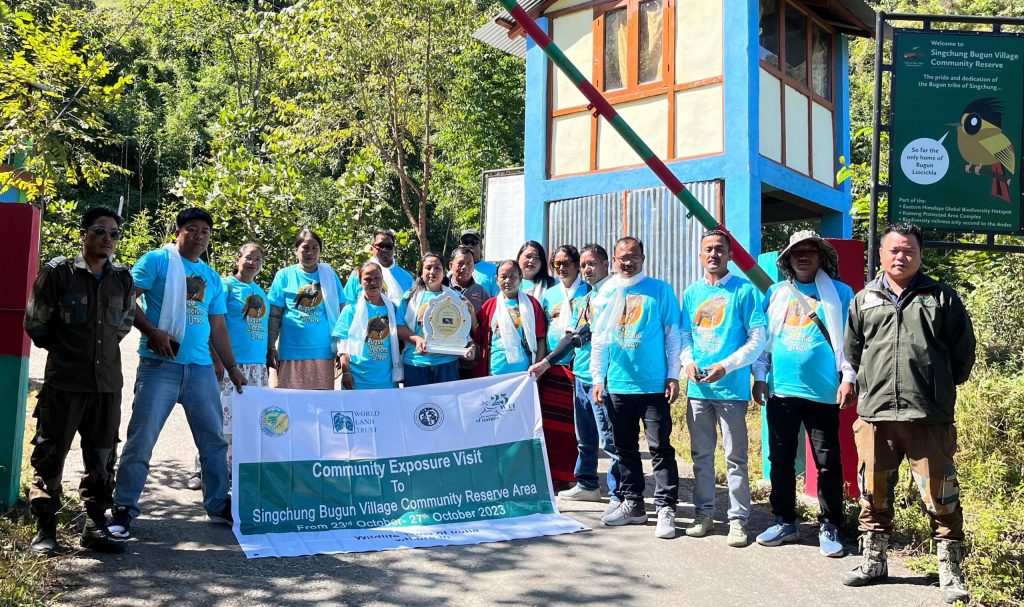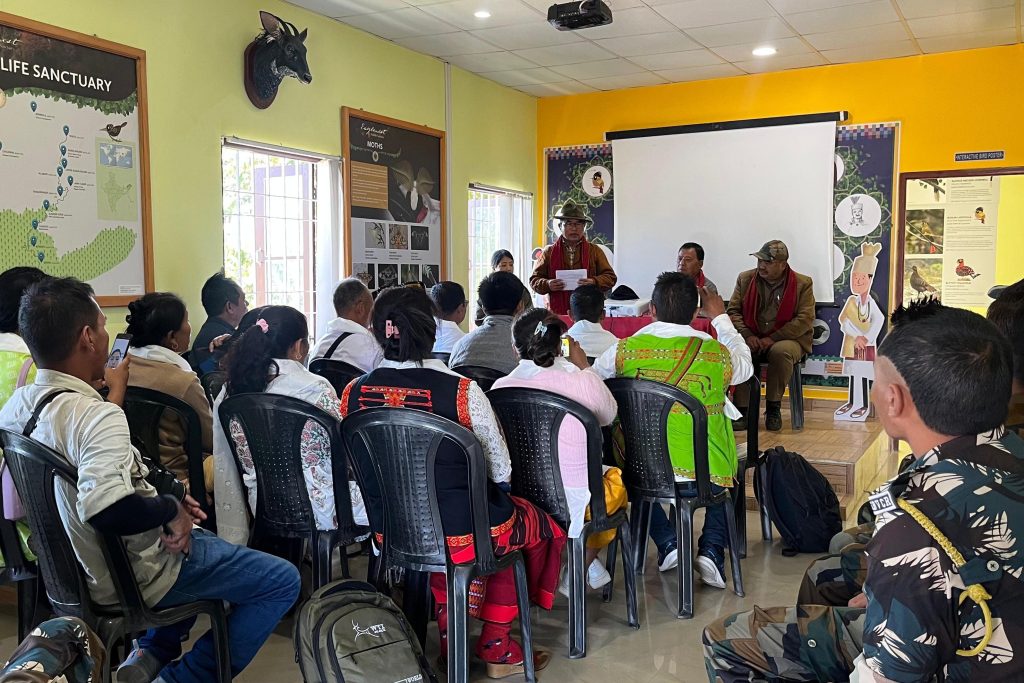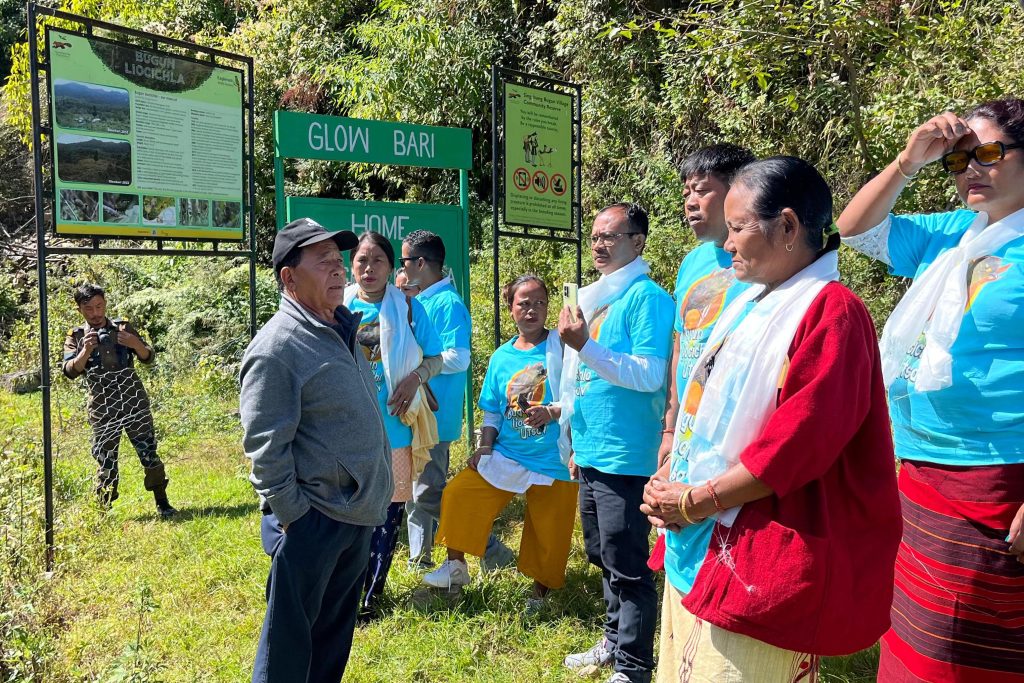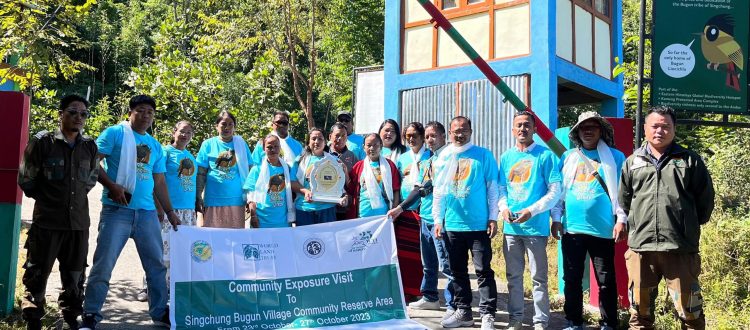WTI facilitates community exposure visit to Singchung Bugun Village Community Reserve Area (SBVCR)
The D’Ering – Dibru Saikhowa Elephant Corridor Link (DDS) project is a community-based conservation project of the Wildlife Trust of India (WTI). The project follows the community securement model to secure the proposed D’Ering – Dibru Saikhowa Elephant Corridor by setting aside the community forest land of Mer, Namsing and Paglam villages of East Siang and Lower Dibang Valley districts of Arunachal Pradesh as “Community Reserve” for the safe passage of elephants and other wildlife in the region. So far the project has directly impacted 820 students, 2586 locals and 56 forest frontline staff through awareness campaigns, community livelihood support, equipping and capacity-building training.

DDS project community beneficiary team exposure visit to Singchung Bugun Community Reserve Area (SBVCR) | Photograph by Dindi Padi/WTI
In the month of October, a team of 14 members of the Kotgah Community Reserve Society (KCRS) committee, community stakeholders and community members of Mer, Namsing and Paglam villages (the beneficiary villages of the DDS Corridor project) made an exposure tour visit to Singchung Bugun Village Community Reserve Area (SBVCR) in West Kameng, Arunachal Pradesh. The two-day visit to the SBVCR area was organised by Wildlife Trust of India (WTI) with the support of World Land Trust (WLT) with an objective to provide insights and understanding about the management of “Community Reserve (CR)” and the potential sustainable economic benefits available to the local communities upon the formation of CR.
The first day of the tour started with Shri. Khandu Glow, the Chairman of the SBVCR committee talking about the historical background of the Singchung Bugun Village Community Reserve area and the various initiatives undertaken by the Bugun community to ensure the sustainable conservation of the ‘Critically Endangered’ Bugun Liocichla bird as well as livelihoods of the local community.

Session with Shaleena Pinya on documentation of wildlife by local community | Photograph by Dindi Padi/WTI
The session with Shri. Khandu Glow emphasised the need for the community’s sense of responsibility and belongingness in order to drive wildlife and nature conservation action. He also suggested that naming a community reserve based on an individual species or the landscape sets the intention of the community and their pride towards conserving wildlife. This was followed by a session by Shri. Indi Glow, a pioneer in bird tourism from the Singchung region where he discussed the prospects of eco-tourism and its potential to boost the local economy. Additionally, Miss Shaleena Pinya, a member of the Forest Protection Squad of SBVCR, led an engaging session on the significance and technical aspects of documentation and species record keeping by the local community. These efforts can significantly contribute towards highlighting the potential wildlife conservation and global tourism prospect of the “Community Reserve”.

The team at “Glow Bari” area inside SBVCR dedicated to Bugun Liocichla by Bugun Community | Photograph by Dindi Padi/WTI
The following day, the community members visited the Singchung Bugun Village Community Reserve Area (SBVCR). The team visited “Glow Bari”, a protected area under SBVCR dedicated as the habitat for the Bugun Liocichla. An interactive session with the Self-Help Group (SHGs) women was also organised in the “Lama Camp” which is a pit stop for tourists visiting the area thus catering to the local economy of the Bugun community.
As the chair of the SBVCR management committee and a member of the Bugun community, Shri Khandu Glow emphasised liaisoning with the forest department to ensure the sustainability of funding support to make the “Community Reserve” a success for both the wildlife as well as people. He also stressed upon initially initiating a credible and consistent CR management regulation among the local communities to gain recognition and support from other agencies. For instance, the Bugun community initiative to set aside community forest land to protect a bird species gained support from the Rainforest Trust, a U.S.based non-profit environment organisation. Additionally, SBVCR was recognised as the “Best Conserved Community Forests” by the Arunachal State Government and won the India Biodiversity Award in the “Conservation of Wildlife Species” category in 2018 which aided in securing financial support for SBVCR management. Furthermore, the Arunachal Pradesh Forest Department has been supporting the forest protection squad of the SBVCR area and other organisations like Wildlife Trust of India (WTI) have been providing GPS devices to the patrolling team. The Bugun bird tourism business also generates employment and other business opportunities for people living in the nearby SBVCR area. In this regard, it is essential to acknowledge the collaborative efforts of the local community with other organisations to establish a successful “Community Reserve.”
The two-day tour visit to SBVCR served as an ensemble of exposure that showcased the success of community-based conservation model for beneficiaries of the DDS project.









